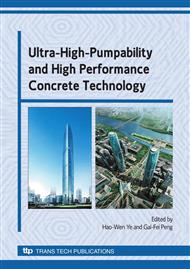p.44
p.50
p.55
p.62
p.69
p.77
p.83
p.89
p.96
Ultra High Performance Cementitious Hybrid and Flexural Analysis of the UHPCC-NC Hybrid Structure with Full Shear Connection
Abstract:
The analysis of material variables and curing procedure design are the key techniques of UHPCC. Material variables include cement-water ratio, silica fume content, sand’s content and size, filling powder’s content and type. Based on the objective of compressive strength, UHPCC with compressive strength 180MPa was developed based on the influence analysis of material variables on its performances and the substitution of silica fume by lime stone powder. By the analysis of the influences of early curing method, initial time, duration time and high temperature curing, curing procedure design was proposed, i.e. early water curing at first after 24 hours of casting and then high temperature steam curing. Based the simplified constitutive relation of UHPCC, the ultimate flexural of UHPCC hybrid girder was analyzed. This paper can be a basis of UHPCC-NC hybrid structure analysis.
Info:
Periodical:
Pages:
69-74
Citation:
Online since:
January 2009
Authors:
Price:
Сopyright:
© 2009 Trans Tech Publications Ltd. All Rights Reserved
Share:
Citation:


